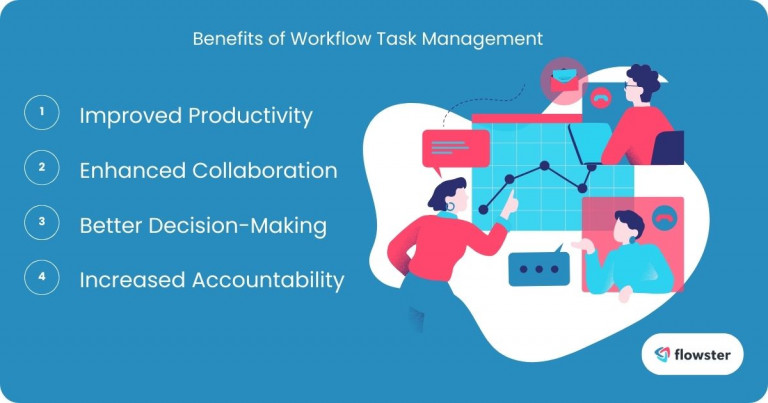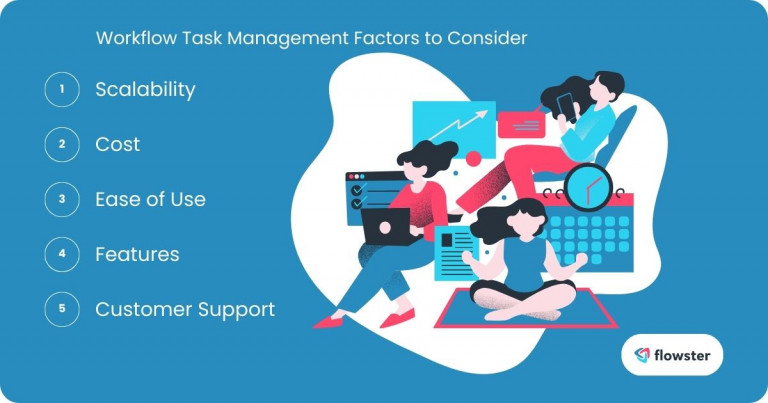In today’s fast-paced business landscape, growing companies often find themselves overwhelmed by the sheer volume of tasks and projects. Juggling multiple responsibilities, tracking deadlines, and ensuring efficient collaboration can be a daunting challenge. This is where workflow task management comes into play.
Workflow task management refers to the systematic process of organizing, prioritizing, and tracking tasks to streamline operations and improve efficiency. It involves using tools and strategies to break down complex projects into manageable steps, assign tasks to team members, and monitor progress. By implementing effective workflow task management systems, businesses can enhance productivity, improve collaboration, and ultimately achieve their goals.
In this blog post, we will delve into the world of workflow task management, exploring its benefits, use cases, and how it works. We will also discuss key factors to consider when selecting the right system for your growing business.
Article Outline
What is Workflow Task Management?
Workflow task management is a systematic approach to organizing, prioritizing, and tracking tasks within a business. It involves breaking down complex projects into smaller, more manageable steps and assigning these tasks to team members. By effectively managing workflows, businesses can improve efficiency, enhance collaboration, and ultimately achieve their goals.
Definition
At its core, workflow task management is about creating a structured process for completing tasks. This involves:
- Task identification: Identifying all the tasks required to complete a project or process.
- Task prioritization: Determining the order in which tasks should be completed based on their importance and urgency.
- Task assignment: Assigning tasks to specific team members or departments.
- Task tracking: Monitoring the progress of tasks and ensuring they are completed on time.
- Task communication: Ensuring clear and effective communication between team members regarding task assignments, deadlines, and expectations.
Importance
Workflow task management is crucial for business growth and efficiency for several reasons:
- Improved productivity: By organizing tasks and assigning them to the right people, businesses can avoid bottlenecks and ensure that resources are used effectively.
- Enhanced collaboration: Workflow task management promotes teamwork and collaboration by providing a clear overview of everyone’s responsibilities and deadlines.
- Better decision-making: By tracking progress and identifying potential issues early on, businesses can make informed decisions and take corrective action as needed.
- Increased accountability: When tasks are clearly assigned and tracked, it becomes easier to hold individuals accountable for their performance.
As we have seen, workflow task management is a valuable tool for businesses of all sizes. In the next section, we will explore the specific benefits that workflow task management can offer.

Benefits of Workflow Task Management
Workflow task management offers a wide range of benefits for businesses of all sizes. By implementing effective workflow management systems, companies can improve efficiency, enhance collaboration, and make data-driven decisions.
Improved Productivity
One of the most significant benefits of workflow task management is increased productivity. By organizing tasks, assigning them to the right people, and tracking progress, businesses can:
- Reduce wasted time: By minimizing the time spent searching for information or switching between tasks, employees can focus on completing their work more efficiently.
- Avoid bottlenecks: By identifying and addressing potential bottlenecks in the workflow, businesses can ensure that tasks are completed on time and avoid delays.
- Optimize resource allocation: By understanding the workload of each team member, businesses can allocate resources effectively and prevent burnout.
Enhanced Collaboration
Workflow task management also fosters better collaboration among team members. By providing a centralized platform for communication and coordination, businesses can:
- Improve communication: By ensuring that everyone is on the same page regarding task assignments, deadlines, and expectations, businesses can reduce misunderstandings and improve communication.
- Increase transparency: By making it easy for team members to see the progress of their colleagues, businesses can increase transparency and accountability.
- Facilitate teamwork: By breaking down complex projects into smaller, more manageable tasks, workflow task management can make it easier for teams to work together effectively.
Better Decision-Making
Workflow task management can also support data-driven decision-making. By tracking progress, identifying trends, and analyzing performance metrics, businesses can:
- Make informed decisions: By having access to accurate and up-to-date data, businesses can make informed decisions about resource allocation, project prioritization, and process improvement.
- Identify areas for improvement: By analyzing performance data, businesses can identify areas where they can improve efficiency and reduce costs.
- Measure success: By tracking key performance indicators, businesses can measure the success of their workflow management initiatives.
Increased Accountability
Finally, workflow task management can help ensure accountability and transparency. By assigning tasks to specific individuals and tracking their progress, businesses can:
- Hold individuals accountable: By making it clear who is responsible for each task, businesses can hold individuals accountable for their performance.
- Improve transparency: By providing a clear overview of task assignments and progress, businesses can increase transparency and build trust among team members.
- Prevent delays: By identifying and addressing issues early on, workflow task management can help prevent delays and ensure that projects are completed on time.
As we have seen, workflow task management offers a wide range of benefits for businesses. In the next section, we will explore some of the specific use cases for workflow task management.

Use Cases for Workflow Task Management
Workflow task management can be applied to a wide range of business processes, from project management to human resources. Here are some common use cases:
Project Management
Workflow task management is an essential tool for effective project management. By breaking down complex projects into smaller, more manageable tasks, businesses can:
- Improve project visibility: By tracking the progress of each task, businesses can gain a clear understanding of project status and identify potential risks.
- Enhance collaboration: Workflow task management can facilitate collaboration among team members by providing a centralized platform for communication and coordination.
- Ensure timely delivery: By setting deadlines for each task and tracking progress, businesses can ensure that projects are delivered on time and within budget.
Customer Service
Workflow task management can also help streamline customer service processes and improve customer satisfaction. By creating standardized workflows for handling customer inquiries and complaints, businesses can:
- Reduce response times: By assigning tasks to the appropriate team members and tracking progress, businesses can reduce response times and improve customer satisfaction.
- Improve customer experience: By providing a consistent and efficient customer service experience, businesses can build customer loyalty and increase repeat business.
- Identify areas for improvement: By tracking customer feedback and analyzing performance metrics, businesses can identify areas where they can improve their customer service processes.
Sales and Marketing
Workflow task management can also be used to optimize sales and marketing efforts. By creating workflows for lead generation, sales follow-up, and marketing campaigns, businesses can:
- Increase sales efficiency: By automating repetitive tasks and streamlining sales processes, businesses can increase sales efficiency and close deals faster.
- Improve lead management: By tracking lead interactions and progress, businesses can improve their lead management processes and convert more leads into customers.
- Measure marketing effectiveness: By tracking the performance of marketing campaigns and analyzing customer data, businesses can measure the effectiveness of their marketing efforts.
Human Resources
Workflow task management can also be used to manage HR tasks and improve employee efficiency. By creating workflows for recruitment, onboarding, performance reviews, and employee development, businesses can:
- Streamline HR processes: By automating repetitive HR tasks, businesses can streamline their HR processes and save time.
- Improve employee experience: By providing a clear and efficient onboarding process, businesses can improve the employee experience and reduce turnover.
- Enhance talent management: By tracking employee performance and identifying development opportunities, businesses can enhance their talent management capabilities.
As we have seen, workflow task management can be applied to a wide range of business processes. In the next section, we will explore how workflow task management works.
Flowster's AI-Driven Automation
How Workflow Task Management Works
Workflow task management systems are typically composed of several key components that work together to streamline processes and improve efficiency.
Key Components
- Task creation: Users can create new tasks, assign them to team members, and set due dates.
- Task assignment: Tasks can be assigned to individuals or teams, and priorities can be set to ensure that critical tasks are addressed first.
- Task tracking: The system tracks the progress of each task, allowing users to monitor deadlines and identify potential bottlenecks.
- Task communication: Workflow task management systems often include features that facilitate communication between team members, such as comments, notifications, and shared calendars.
- Reporting: The system can generate reports on task completion rates, project progress, and other key performance indicators.
Workflow Automation
One of the key advantages of workflow task management systems is their ability to automate repetitive tasks. Automation can help to:
- Reduce manual labor: By automating tasks, businesses can free up employees to focus on more strategic work.
- Improve accuracy: Automation can help to reduce errors and ensure that tasks are completed correctly.
- Increase efficiency: By streamlining processes, automation can help to improve overall efficiency and productivity.
Integration with Other Tools
Many workflow task management systems can be integrated with other business tools, such as email, CRM, and project management software. This integration can help to:
- Improve data flow: By integrating with other systems, businesses can avoid duplicate data entry and ensure that information is always up-to-date.
- Enhance collaboration: Integration can facilitate collaboration between teams by providing a centralized platform for communication and coordination.
- Streamline workflows: By automating data transfer between systems, businesses can streamline their workflows and reduce manual tasks.
As we have seen, workflow task management systems offer a range of features and benefits that can help businesses improve efficiency, productivity, and collaboration. In the next section, we will discuss some of the key factors to consider when choosing a workflow task management system.

Choosing the Right Workflow Task Management System
When selecting a workflow task management system, it is essential to consider several factors to ensure that the system meets your business needs.
Factors to Consider
- Scalability: As your business grows, your workflow task management system should be able to scale to accommodate increasing workloads and team sizes.
- Cost: Consider the cost of the system, including licensing fees, implementation costs, and ongoing maintenance expenses.
- Ease of use: The system should be easy to use for both administrators and end-users. Look for a system with a user-friendly interface and intuitive features.
- Features: Consider the specific features that are important to your business, such as task prioritization, time tracking, project management, and integration with other tools.
- Customer support: Look for a system with excellent customer support to ensure that you can get help when you need it.
Popular Options
There are many popular workflow task management tools available, each with its own unique features and benefits. Some popular options include:
- Asana: A popular cloud-based tool that offers a variety of features, including task management, project management, and team collaboration.
- Trello: A visual task management tool that uses boards, lists, and cards to organize tasks.
- Flowster: Streamline processes, boost collaboration, and improve productivity with this powerful workflow task management solution.
- Monday.com: A customizable platform that can be adapted to fit the specific needs of different businesses.
- ClickUp: A versatile tool that offers a wide range of features, including task management, project management, and time tracking.
The best workflow task management system for your business will depend on your specific needs and preferences. By carefully considering the factors outlined above, you can select a system that will help you improve efficiency, productivity, and collaboration.
The Power of Workflow Task Management: A Recap
In this blog post, we have explored the concept of workflow task management and its significance for businesses of all sizes. We have discussed the benefits of workflow task management, including improved productivity, enhanced collaboration, better decision-making, and increased accountability. We have also examined various use cases, from project management to human resources, where workflow task management can be applied.
Additionally, we have delved into the key components of a workflow task management system, including task creation, assignment, tracking, and reporting. We have discussed how automation can streamline processes and reduce manual tasks, and how integration with other business tools can enhance collaboration and data flow.
Conclusion
By implementing an effective workflow task management system, businesses can optimize their operations, improve efficiency, and achieve their goals. It is a valuable tool for streamlining processes, enhancing collaboration, and making data-driven decisions.
Get Started With Free Workflow Templates
We encourage you to explore the world of workflow task management and find a system that best suits your business needs. To help you get started, Flowster Marketplace offers a variety of free workflow templates and other task templates that you can customize and implement.
If you’re looking for a more comprehensive solution, Flowster also provides “Done-for-You” services to help you set up and optimize your workflow task management system. By leveraging the power of workflow task management, you can take your business to new heights.




